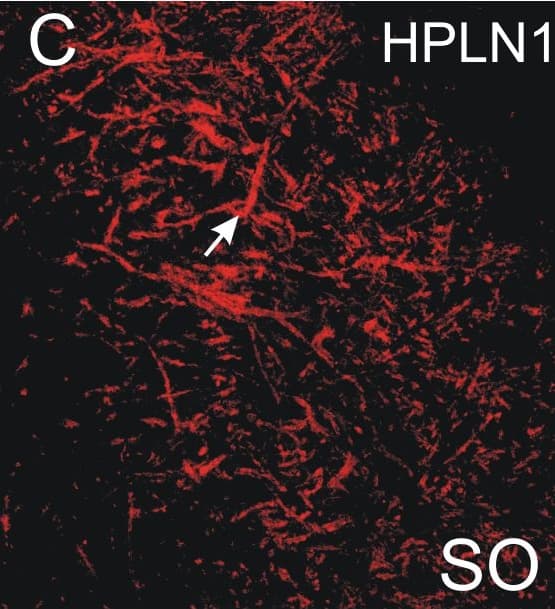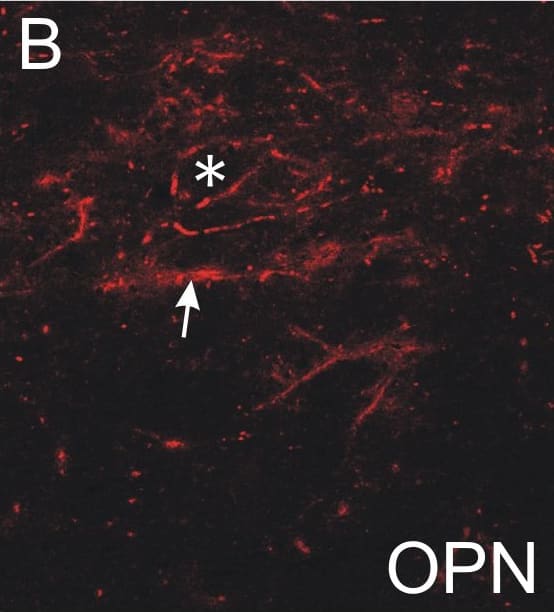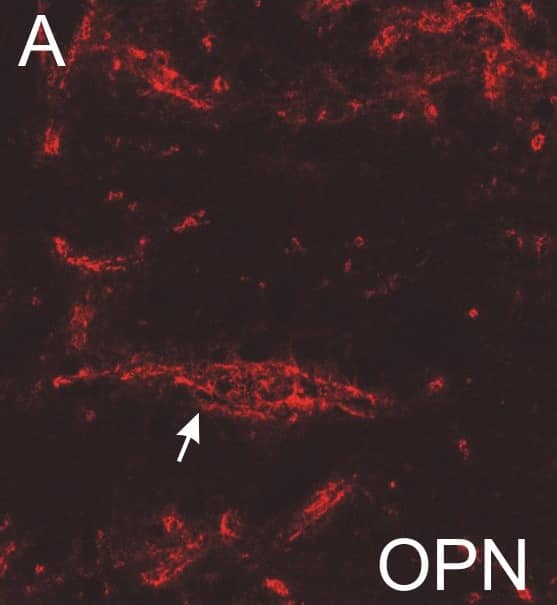Human HAPLN1 Antibody Summary
Asp16-Asn354
Accession # P10915
Customers also Viewed
Applications
Please Note: Optimal dilutions should be determined by each laboratory for each application. General Protocols are available in the Technical Information section on our website.
Scientific Data
 View Larger
View Larger
Detection of Human HAPLN1 by Immunocytochemistry/Immunofluorescence Absent or fragmented omnipause neuron perineuronal net triple immunofluorescence staining.Triple immunofluorescence staining for different components of perineuronal nets, revealed by a confocal laser scanning microscope. In the control case, omnipause neurons (OPN) are ensheathed by prominent perineuronal nets showing the same appearance with antibodies against the link protein (HPLN1), chondroitin sulfate proteoglycan (CSPG) and aggrecan (ACAN) (A, D, G, arrow). In the saccadic palsy patient, the neurons of the superior olive (SO) from the same sections as OPN are ensheathed by prominent perineuronal nets revealed by immunostaining of HPLN1, CSPG, and ACAN (C, F, I, arrows). However, around OPN (asterisk) in the patient, only HPLN1-based perineuronal nets can be detected, which appear fragmented (B, arrow). CSPG- and ACAN-immunostaining does not reveal perineuronal nets, but only few fragments along a few dendrites (E, H, arrow). Scale bars A,D,G = 20μm; B,C,E,F,H,I = 200μm. Image collected and cropped by CiteAb from the following publication (https://pubmed.ncbi.nlm.nih.gov/26135580), licensed under a CC-BY license. Not internally tested by R&D Systems.
 View Larger
View Larger
Detection of Human HAPLN1 by Immunocytochemistry/Immunofluorescence Absent or fragmented omnipause neuron perineuronal net triple immunofluorescence staining.Triple immunofluorescence staining for different components of perineuronal nets, revealed by a confocal laser scanning microscope. In the control case, omnipause neurons (OPN) are ensheathed by prominent perineuronal nets showing the same appearance with antibodies against the link protein (HPLN1), chondroitin sulfate proteoglycan (CSPG) and aggrecan (ACAN) (A, D, G, arrow). In the saccadic palsy patient, the neurons of the superior olive (SO) from the same sections as OPN are ensheathed by prominent perineuronal nets revealed by immunostaining of HPLN1, CSPG, and ACAN (C, F, I, arrows). However, around OPN (asterisk) in the patient, only HPLN1-based perineuronal nets can be detected, which appear fragmented (B, arrow). CSPG- and ACAN-immunostaining does not reveal perineuronal nets, but only few fragments along a few dendrites (E, H, arrow). Scale bars A,D,G = 20μm; B,C,E,F,H,I = 200μm. Image collected and cropped by CiteAb from the following publication (https://pubmed.ncbi.nlm.nih.gov/26135580), licensed under a CC-BY license. Not internally tested by R&D Systems.
 View Larger
View Larger
Detection of Human HAPLN1 by Immunocytochemistry/Immunofluorescence Absent or fragmented omnipause neuron perineuronal net triple immunofluorescence staining.Triple immunofluorescence staining for different components of perineuronal nets, revealed by a confocal laser scanning microscope. In the control case, omnipause neurons (OPN) are ensheathed by prominent perineuronal nets showing the same appearance with antibodies against the link protein (HPLN1), chondroitin sulfate proteoglycan (CSPG) and aggrecan (ACAN) (A, D, G, arrow). In the saccadic palsy patient, the neurons of the superior olive (SO) from the same sections as OPN are ensheathed by prominent perineuronal nets revealed by immunostaining of HPLN1, CSPG, and ACAN (C, F, I, arrows). However, around OPN (asterisk) in the patient, only HPLN1-based perineuronal nets can be detected, which appear fragmented (B, arrow). CSPG- and ACAN-immunostaining does not reveal perineuronal nets, but only few fragments along a few dendrites (E, H, arrow). Scale bars A,D,G = 20μm; B,C,E,F,H,I = 200μm. Image collected and cropped by CiteAb from the following publication (https://pubmed.ncbi.nlm.nih.gov/26135580), licensed under a CC-BY license. Not internally tested by R&D Systems.
Preparation and Storage
- 12 months from date of receipt, -20 to -70 °C as supplied.
- 1 month, 2 to 8 °C under sterile conditions after reconstitution.
- 6 months, -20 to -70 °C under sterile conditions after reconstitution.
Background: HAPLN1
HAPLN1 (also known as link protein and CRTL1) is a member of the hyaladherin family of hyaluronic acid (HA) binding proteins. Hyaluronan binding proteins are of two types; those with link modules, and those without. Link modules are 100 amino acid (aa) HA and protein-binding sequences that contain two alpha -helices and two antiparallel beta -sheets (1, 3). There are three categories of link module-containing proteins. “A” domain-type proteins contain one link module; “B” domain-type proteins contain one link module with an N- and C-terminal flanking region; and “C” domain-type proteins have an extended structure with one N-terminal V-type Ig-like domain followed by two link modules (2). The HAPLN family is a group of four C domain-type proteins that share approximately 50% aa identity (4). HAPLN1 is synthesized as a 354 aa precursor that contains a 15 aa signal sequence and a 339 aa mature region (4 - 6). It contains one Ig-like domain and two 95 aa link modules (6). It is variably glycosylated with a native molecular weight between 41 - 48 kDa (7, 8). Mature human HAPLN1 is 97%, 96%, 96%, 96%, and 96% aa identical to equine, porcine, rat, mouse and bovine HAPLN1, respectively. HAPLN1 contributes to extracellular matrix stability and flexibility (9). In cartilage, HALPN1 forms a ternary complex with HA and aggrecan. This creates a gel-like substance with remarkable resistance to deformation (3). In this complex, HA forms a linear backbone with perpendicularly attached aggrecan and HAPLN1. Aggrecan and HAPLN1 lie parallel to each other, while HA runs between the two HAPLN1 link modules (2, 3, 10). The Ig domain of HAPLN1 binds to aggrecan, while the two link modules of HAPLN1 bind to HA. Although HA and aggrecan will associate, the tendency is towards dissociation (2, 3, 8). HAPLN1 provides a stabilizing influence on HA-aggrecan associations, thus creating a long-lived ternary functional complex.
- Day, A.J. and G.D. Prestwich (2002) J. Biol. Chem. 277:4585.
- Seyfried, N.T. et al. (2005) J. Biol. Chem. 280:5435.
- Matsumoto, K. et al. (2003) J. Biol. Chem. 278:41205.
- Spicer, A.P. et al. (2003) J. Biol. Chem. 278:21083.
- Dudhia, J. and T.E. Hardingham (1990) Nucleic Acids Res. 18:1292.
- Osborne-Lawrence, S.L. et al. (1990) Genomics 8:562.
- Roughley, P.J. et al. (1982) J. Biol. Chem. 257:11908.
- Shi, S. et al. (2004) J. Biol. Chem. 279:12060.
- Binette, F. et al. (1994) J. Biol. Chem. 269:19116.
- Perkins, S.J. et al. (1992) Biochem. J. 285:263.
Product Datasheets
Citations for Human HAPLN1 Antibody
R&D Systems personnel manually curate a database that contains references using R&D Systems products. The data collected includes not only links to publications in PubMed, but also provides information about sample types, species, and experimental conditions.
16
Citations: Showing 1 - 10
Filter your results:
Filter by:
-
Extracellular Matrix Changes in Subcellular Brain Fractions and Cerebrospinal Fluid of Alzheimer's Disease Patients
Authors: L Höhn, W Hu beta ler, A Richter, KH Smalla, AM Birkl-Toeg, C Birkl, S Vielhaber, SL Leber, ED Gundelfing, J Haybaeck, S Schreiber, CI Seidenbech
International Journal of Molecular Sciences, 2023-03-14;24(6):.
-
TREX tetramer disruption alters RNA processing necessary for corticogenesis in THOC6 Intellectual Disability Syndrome
Authors: Werren, EA;LaForce, GR;Srivastava, A;Perillo, DR;Li, S;Johnson, K;Baris, S;Berger, B;Regan, SL;Pfennig, CD;de Munnik, S;Pfundt, R;Hebbar, M;Jimenez-Heredia, R;Karakoc-Aydiner, E;Ozen, A;Dmytrus, J;Krolo, A;Corning, K;Prijoles, EJ;Louie, RJ;Lebel, RR;Le, TL;Amiel, J;Gordon, CT;Boztug, K;Girisha, KM;Shukla, A;Bielas, SL;Schaffer, AE;
Nature communications
Species: Human
Sample Types: Cell Lysates
Applications: ELISA Capture -
HAPLN1 potentiates peritoneal metastasis in pancreatic cancer
Authors: L Wiedmann, F De Angelis, N Vaquero-Si, E Donato, E Espinet, I Moll, E Alsina-San, H Bohnenberg, E Fernandez-, R Mülfarth, M Vacca, J Gerwing, LC Conradi, P Ströbel, A Trumpp, C Mogler, A Fischer, J Rodriguez-
Nature Communications, 2023-04-24;14(1):2353.
Species: Human, Mouse
Sample Types: Cell Lysates, Whole Tissue
Applications: Immunohistochemistry, Western Blot -
N‐glycoproteomics reveals distinct glycosylation alterations in NGLY1‐deficient patient‐derived dermal fibroblasts
Authors: Rohit Budhraja, Mayank Saraswat, Diederik De Graef, Wasantha Ranatunga, Madan G. Ramarajan, Jehan Mousa et al.
Journal of Inherited Metabolic Disease
-
Tau Protein Modulates Perineuronal Extracellular Matrix Expression in the TauP301L-acan Mouse Model
Authors: Sophie Schmidt, Max Holzer, Thomas Arendt, Mandy Sonntag, Markus Morawski
Biomolecules
-
Surfactant protein C is associated with perineuronal nets and shows age-dependent changes of brain content and hippocampal deposits in wildtype and 3xTg mice
Authors: S Schob, J Puchta, K Winter, D Michalski, B Mages, H Martens, A Emmer, KT Hoffmann, F Gaunitz, A Meinicke, M Krause, W Härtig
Journal of chemical neuroanatomy, 2021-10-07;0(0):102036.
Species: Mouse
Sample Types: Whole Tissue
Applications: IHC -
Assessment of Possible Contributions of Hyaluronan and Proteoglycan Binding Link Protein 4 to Differential Perineuronal Net Formation at the Calyx of Held
Authors: Kojiro Nojima, Haruko Miyazaki, Tetsuya Hori, Lydia Vargova, Toshitaka Oohashi
Frontiers in Cell and Developmental Biology
-
Distribution and classification of the extracellular matrix in the olfactory bulb
Authors: Andrea Hunyadi, Botond Gaál, Clara Matesz, Zoltan Meszar, Markus Morawski, Katja Reimann et al.
Brain Structure and Function
-
The protein tyrosine phosphatase RPTP?/phosphacan is critical for perineuronal net structure
Authors: GJ Eill, A Sinha, M Morawski, MS Viapiano, RT Matthews
J. Biol. Chem., 2019-12-10;295(4):955-968.
Species: Mouse
Sample Types: Whole Cells, Whole Tissue
Applications: ICC, IHC -
Synaptic coupling of inner ear sensory cells is controlled by brevican-based extracellular matrix baskets resembling perineuronal nets
Authors: M Sonntag, M Blosa, S Schmidt, K Reimann, K Blum, T Eckrich, G Seeger, D Hecker, B Schick, T Arendt, J Engel, M Morawski
BMC Biol., 2018-09-26;16(1):99.
Species: Mouse
Sample Types: Cell Lysates, Whole Tissue
Applications: IHC, Western Blot -
Chondroitin 6-Sulfation Regulates Perineuronal Net Formation by Controlling the Stability of Aggrecan
Authors: Shinji Miyata, Hiroshi Kitagawa
Neural Plasticity
-
Saccadic Palsy following Cardiac Surgery: Possible Role of Perineuronal Nets.
Authors: Eggers S, Horn A, Roeber S, Hartig W, Nair G, Reich D, Leigh R
PLoS ONE, 2015-07-02;10(7):e0132075.
Species: Human
Sample Types: Whole Tissue
Applications: IHC -
Extracellular matrix molecules exhibit unique expression pattern in the climbing fiber-generating precerebellar nucleus, the inferior olive.
Authors: Kecskes S, Gaal B, Racz E, Birinyi A, Hunyadi A, Matesz C
Neuroscience, 2014-10-17;284(0):412-21.
Species: Rat
Sample Types: Whole Tissue
Applications: IHC -
Semaphorin 3A binds to the perineuronal nets via chondroitin sulfate type E motifs in rodent brains.
Authors: Dick, Gunnar, Tan, Chin Lik, Alves, Joao Nun, Ehlert, Erich M, Miller, Gregory, Hsieh-Wilson, Linda C, Sugahara, Kazuyuki, Oosterhof, Arie, van Kuppevelt, Toin H, Verhaagen, Joost, Fawcett, James W, Kwok, Jessica
J Biol Chem, 2013-08-12;288(38):27384-95.
Species: Mouse
Sample Types: Tissue Homogenates
Applications: Western Blot -
Deconstructing the perineuronal net: Cellular contributions and molecular composition of the neuronal extracellular matrix
Authors: K. A. Giamanco, R. T. Matthews
Neuroscience
-
Perisynaptic aggrecan-based extracellular matrix coats in the human lateral geniculate body devoid of perineuronal nets.
Authors: Lendvai D, Morawski M, Bruckner G, Negyessy L, Baksa G, Glasz T, Patonay L, Matthews RT, Arendt T, Alpar A
J. Neurosci. Res., 2011-09-30;90(2):376-87.
Species: Human
Sample Types: Whole Tissue
Applications: IHC-Fr
FAQs
No product specific FAQs exist for this product, however you may
View all Antibody FAQsIsotype Controls
Reconstitution Buffers
Secondary Antibodies
Reviews for Human HAPLN1 Antibody
Average Rating: 5 (Based on 1 Review)
Have you used Human HAPLN1 Antibody?
Submit a review and receive an Amazon gift card.
$25/€18/£15/$25CAN/¥75 Yuan/¥2500 Yen for a review with an image
$10/€7/£6/$10 CAD/¥70 Yuan/¥1110 Yen for a review without an image
Filter by:


















